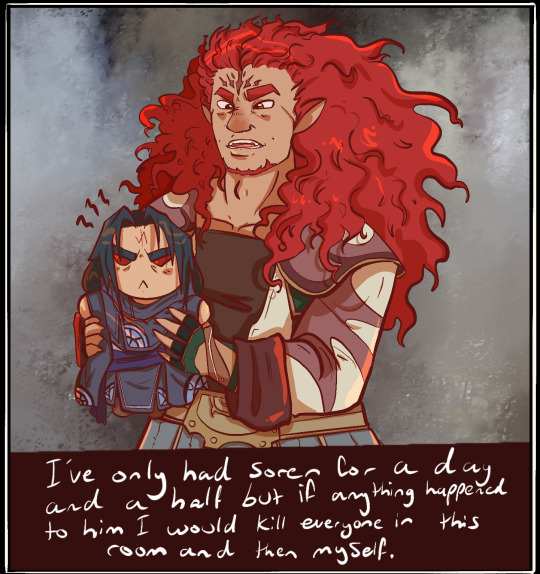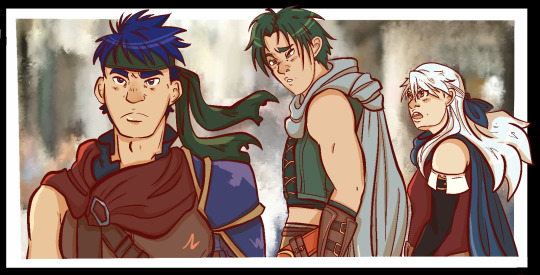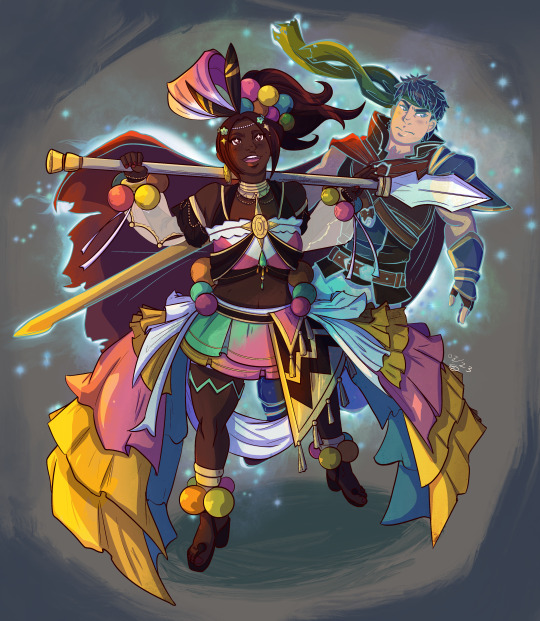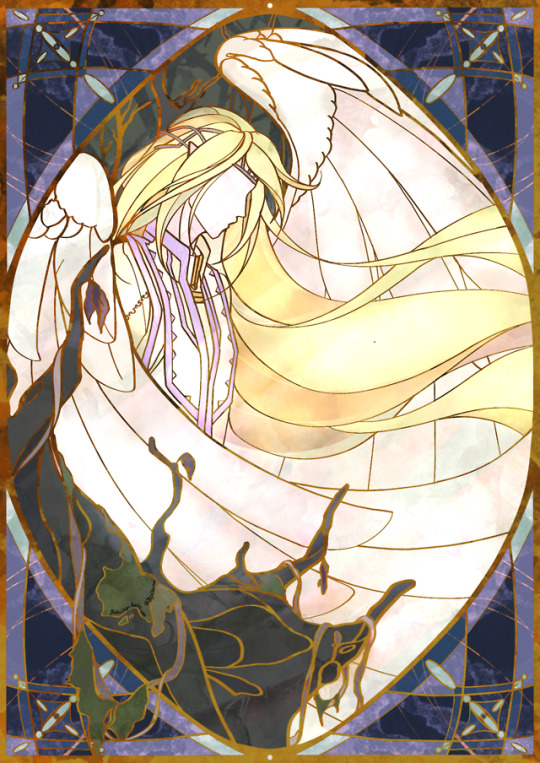#Radient Dawn
Explore tagged Tumblr posts
Text













Massive pile of Fire emblem art: Tellius Edition!
#If I’m normal about Cyborg 009 I’m even more normal about Tellius Fire Emblem#fire emblem radiant dawn#fire emblem path of radiance#Radient Dawn#path of radiance#fanart#Fire emblem#Oh god I have to tag all these characters uhhhh#Ike#maciah#Pelleas#Sothe#Tauroneo#Shinon#Ashura#Yune#Lethe#Skrimir#Soren#Gatrie#Nesala#Tibarn#Leanne#Tormod#Titania#Ranulf#Mordecai#Nailah#Rafiel#Reyson
222 notes
·
View notes
Text






I would really like to play radient dawn someday
1 note
·
View note
Text
Very late but congrats to soren for coming in second for CYL7

#FEH#fe heroes#path of radiance#radient dawn#soren#cyl7#i gave him green party favours cuz he's green#this took me like 20 minutes for some reason
21 notes
·
View notes
Photo

White Prince- Reyson
#Fire Emblem#Fire emblem Heroes#FEH#Nintendo#fe#Fe heroes#Reyson#Laguz#path of radiance#radient dawn#fe9#fe10#Heron#prince#Stained glass
1K notes
·
View notes
Photo


commission for @jewlist ! This was so much fun to work on 🌻
#fire emblem#titania fire emblem#titania#fire emblem heroes#fe9#path of radiance#radient dawn#fire emblem titania#fe10#ive never played these games so if any of the tags are wrong someone lmk !!#fanart#commission#i love drawing clouds sjdkfhkjdsf#90% of this was me screaming on discord abt how much i love drawing clouds#10% of it was me actually drawing
71 notes
·
View notes
Text
So I’ve seen a couple of pictures of Smash Couples and I was so happy to see some because I thought I was this weirdo who was shipping two characters from two different worlds together. I love to get my favorite Mario character in life, Daisy, with Ike from Fire Emblem. Now I’ve never played a single Fire Emblem game, but I just fell in love with Ike in Brawl and now that my Daisy girl is a playable character, I can ship them properly lol

#super smash bros#super smash ultimate#princess daisy#ike#fire emblem#daisy#smash couple#ship it#path of radiance#radient dawn
13 notes
·
View notes
Photo

“S IS FOR SUPPORT RIGHT?”
*insert Ike aggressively taking off his shirt to reveal a Soren tattoo on his chest*
I bet you can’t guess what team I’m on??????
Ryoumu baby I love and support you but you gotta give credit to the opposition.
I hope everyone has fun, I actually can’t wait to see who the finalists are! Until then pray for me to get a second lobster lord qwq~~!!!
Part 2
#feh#fire emblem heroes#voting gauntlet#ryouma#ryoma#xander#marx#fire emblem fates#feif#fe14#soren#ike#path of radiance#radient dawn#summoner oc#kiran#haku#ocs#fire emblem#xianha#comic#ryoumarx#ryomarx#fe heroes
511 notes
·
View notes
Video
youtube
Sanaki Lv. 40 Confession Dub
#Sanaki#Fire Emblem#Heroes#Fandub#FEH#Voice Actor#Confession#Support Conversation#Path of Radience#Radient Dawn
5 notes
·
View notes
Photo

Ike from Fire Emblem: Path of Radiance drinks pilk!
#pilk drinker#ike fire emblem#ike fe#fire emblem ike#fe ike#fire emblem#fire emblem path of radiance#fire emblem: path of radiance#fire emblem radiant dawn#fire emblem: radient dawn#feh#fire emblem heroes#requested
16 notes
·
View notes
Quote
The problem is Shinon is a good unit. You'd think that wouldn't be a problem, but the problem is he's a cunt.
My little brother on Dec 26th, 2018
8 notes
·
View notes
Photo


They would talk about meat, fighting styles, and Soran because he’s effing amazing

side sketch, im terrible at body types
#Fire emblem#fire emblem awakening#fire embem radient dawn#robin#F!Robin#Ike#We like ike#My Unit#F!My unit
17 notes
·
View notes
Text
I love echos so much like it might be my second favorite or favorite game in the franchise
2 notes
·
View notes
Photo

Sketchtember 07 Very Sketchy Michaiah from Radient Dawn. Feel free to finish her / make her better!
Posted using PostyBirb
4 notes
·
View notes
Text
THINKING ABOUT FIRE EMBLEM RADIENT DAWN MANY THOUGHTS HEAD FULL
1 note
·
View note
Text

The ancient Sumerian pantheon is vast, containing many lesser and greater deities, it is as follows:
Abu: Abu means “father of plants and vegetation”, he was one of eight minor deities born to heal the illness of Enki. As his name suggests he was a God of vegetation and probably specifically governed healing herbs.
Abzu: Abzu is the primordial God of fresh water who merged with the primordial Goddess of salt water (Tiamat/Nammu) to form the universe. The divine union or Hieros Gamos of Abzu and Nammu birthed the Gods thus Abzu is the “all father”, Abzu was murdered by the other Gods who sought to steal his power.
Adad (Ishkur): Known as the “Lion of Heaven” and “great radient bull” Adad was a storm God made inspector of the cosmos by Enki. Adad is sometimes the son of the moon God Nanna/Sin born by the Goddess Ningal and is thus the brother of the sun God Shamash/Utu and Ishtar/Inanna. Adad is also sometimes considered a son of Enlil. Adad’s consort was the grain Goddess Shala/Ninlil who bore him the fire God Gibil. Adad was known to bring life giving rain but also destruction, he was often depicted with a horned helmet and a spear made of lightning. Both Adad and Shamash are associated with divination, Adad was associated with divination by water. This deity probably influenced the later Cannanite deity Ba’al Hadad.
Agasaya: An early war Goddess who became indistinct from Ishtar once Ishtar became known as the “warrior of the sky”.
Ama-arhus: A fertility Goddess.
Amasagnul: A fertility Goddess.
Amathaunta: Goddess of the ocean, she was known to be worshiped by Sumerian migrants in Egypt and is thought to be the Biblical Goddess Ashima.
Anshar: Meaning “Whole Heaven” and whose consort was Kishar meaning “Whole Earth”. Anshar was a primordial God and son of the deities Lahamu and Lahmu which also makes him the grandchild of Tiamat/Nammu and Abzu created from the split between heaven and earth in the death of Tiamat. Anshar and Kishar were in turn parents of Anu the sky God representing heaven.
Antu: Antu was a Goddess originally paired with Anu but eventually her attributes were replaced by Ishtar. Her place as consort of Anu was quickly replaced with the Goddess Ki.
Anu: Anu was God of heaven and the sky, he was said to have created the stars as warriors against the wicked. Anu was given the power of judgement over souls. Anu was the son of the deities Anshar and Kishar. Anu’s consort was the earth Goddess Ki and their sacred marriage or divine union birthed the other Gods known as the “Anunnaki” - “Children of Anu and Ki”/“Those who came down from heaven to earth”. When Enlil became the king of Gods the positions previously held by Anu were absorbed into Enlil’s mythology.
Asaruludu: Known as the “Light of the Gods” and “Wielder of the flaming sword”. Asaruludu was a protective God.
Ashnan: Ashnan was Goddess of grain created alongside her brother Lahar by the other Anunnaki when they engineered grain and cattle as a food source.
Ashur: Ashur was an Akkadian varient of Enlil who was often depicted in the centre of a winged disk holding a bow and arrow, giving blessings or in a disk with horns. He was named for the city Assur. His iconography inspired the later Zoroastrian/Persian Faravahar.
Aya: Aya meaning “Dawn” was the Goddess of the rising sun, sexual love and youth, she was the consort of the sun God Shamash and was known as “Kallatu” meaning “The Bride”. Aya played a ritual part in the merging of herself with Shamash in the Hieros Gamos rituals of Hasadu for this reason she was probably revered alongside Ishtar by temple prostitutes/priestesses.
Azimua: Azimua was one of eight deities born to cure the illness of Enki. Azimua was Goddess of healing and was consort of the God Ningishzida. Combining the caduceus symbol with medicinal knowledge as it is even in the modern age.
Belet-Seri: Belet-Seri was an underworld Goddess said to be the recorder of the dead entering the underworld, she is known as the “Scribe of the Earth”. It is Belet-Seri who keeps the records of human activities so that she can advise the queen of the dead, Ereshkigal on their final judgment in the afterlife. Belet-Seri is married to Amurru the God of nomads, she is known as “Queen of the Desert”. Amurru is a Semitic God that was adopted into Sumerian culture.
Birdu: Birdu was a God of the underworld and consort of Manungal. Birdu would come to be identified as Nergal in later mythologies however the mythologies describing him as Birdu are incomplete and partially destroyed.
Dagon: Dagon was a fertility God whose consorts were Shala/Ninlil (who was also consort of Adad) and Ishara. Dagon was a war God and protector sometimes equated with Enki. Dagon was made prison warden of the underworld in later myths and developed into a Semitic fish-grain deity that likely came to influence the Egyptian deity Rem and also may be the origin of the English word “Dragon”.
Damgalnuna: Damgalnuna was a mother Goddess and consort of Enlil. Damgalnuna became the Akkadian Damkina the consort of Enki/Ea and mother of Marduk.
Damu: Damu was a God of vegitation and rebirth as well as a healing deity he was also known to be an exorcist as the concept of healing and driving out evil spirits were linked in the ancient mind.
Emesh: Emesh was a vegetation deity created alongside Enten, he was charged with responsibility on Earth for woods, fields, sheeo folds and stables by Enlil. Emesh is identified with the bountiful abundance of the Earth and with summertime.
Enbilulu: Enbilulu was a God of rivers and waters. Enbilulu was placed in charge of the sacred rivers Tigris and Euphrates by the God Enki. Enbilulu was also the God of agriculture and irrigation. In the Sumerian “Enlil and Ninlil” story Enbilulu is the son of Enlil and Ninlil. In later Babylonian times he becomes the son of Ea and is connected with Adad. Enbilulu is said to know the secrets of the waters and of the rivers running below the earth” he is also known as “the lord who makes all things flourish” who regulates the land, the grazing and watering places, who opened the wells and thereby apportioned the waters of abundance. Enbilulu was seen to be split into three lesser deities:
-Epadun: “The lord who sprinkles the field” who knows the most subtle geometries of the Earth.
-Enbilulugugal: “Lord of abundance, opulence and ample crops”, the power that presides over all growth and all things that grow.
-Hegal: “Who provides rich rains over the wide Earth and provides vegetation for the people’s consumption”, often called the master of the arts of farming and agriculture as well as one who knows all secrets of metals.
Endursaga: Endursaga was a herald God who lead the other Gods in times of battle. In later Akkadian mythology he became Ishum.
Enki: Meaning “Lord of the Earth” was an ocean God also associated with crafts and mischief, intelligence, creation and beer. Enki was also considered the master shaper of the world, God of wisdom and of all alchemy and magic as well as keeper of the secret me’s (laws/divine orders). Enki is often depicted as wearing a horned crown and dressed in the skin of a carp he is usually depicted between two rivers (the Tigris and Euphrates) which are his domain. Enki is also sometimes depicted between a female and male tree that he as an alchemist would combine to create life, likewise he is also sometimes depicted holding a caduceus-like symbol or rod. Enki is one of the Anunnaki born of the union of Anu and Ki. Enki is the God that suggests the initial creation of mankind after the rebellion of the Igigi. Enki was seen as responsible for confounding the language of mankind but also sent the seven Apkallu sages to teach various arts to humanity. When humanity overpopulated the world and Enlil endevours to destroy them it is Enki who spares them by convincing Atrahasis to build his ark. Enki is said to have performed sacred marriage or Hieros Gamos with his consort the nature Goddess Ninhursag who then gave birth to the Goddess Ninsar before abandoning Enki. Unaware that Ninsar is his daughter Enki seduces her and she births the Goddess Ninkurra before abandoning Enki who then seduces Ninkurra who births the Goddess Uttu. Uttu is then also impregnated by Enki but after consulting with Ninhursag releases Enki’s semen onto the ground which in turn births eight plants. Unknowingly Enki eats fruit of the plants and becomes pregnant with his own semen, unable to birth without a womb Enki is diying and so Ninhursag takes the semen into her own body and births several deities of healing to rescue Enki.
Enkimdu: (Possibly an aspect of Enki) Enkimdu is a God of farming and vegetation who features prominently in myth where he argues with Tammuz over who will win Ishtar’s hand in marriage, at first Ishtar seems to prefer Enkimdu but later myths make it clear the she partners with Tammuz instead.
Enlil: Enlil is a storm, sky and air God of the heavens and winds and was eventually the chief God of the Sumerian pantheon. Enlil was an Anunnaki born of the union of Anu and Ki. Enlil features heavily throughout Mesopotamian mythology but is best known for causing the great flood in an effort to kill humanity. Enlil was also responsible for creating Asu-Shu-Namir from the dust under his fingernails in order to rescue Ishtar from the underworld. Enlil’s consort was Ninlil who gave birth to the moon God Sin and the war God Ninurta. Enlil is also father of Nisaba, Pabilsag and Enbilulu. Through a union with the death Goddess Ereshkigal, Enlil was also the father of Namtar. In one myth Enlil advises his son Ninurta through the enchanted mace Sharur on how to kill the demon Asag. Enlil is sometimes synonymous with Marduk.
Enmesarra: Enmesarra was an underworld Sun God (symbolising the sun when it crossed the horizon bringing night) and thus more accurately embodied darkness. Enmesarra was the protector of flocks and vegetation as well as the God of the underworlds laws.
Ennugi: Ennugi is the attendant and throne-bearer of Enlil.
Enshag: Enshag was one of the deities born to heal Enki and was made lord of Dilmun by Enki for his services.
Enten: Was created alongside Emesh, Enten was a vegetation and cattle God who was important to fertility and the fertility of the land and cattle. Enten was appointed his duties by Enlil which included insuring the fertility of animals. Enten is associated with winter and abundance.
Erra: Erra was a God of plague and confusion and thus chaos. Erra was said to have taken over the throne of Marduk for a time causing the world to spiral into chaos. In this myth the Sibitti (minor deities in the form of weapons) call upon Erra to destroy mankind who are ultimately saved causing Erra and the Sibitti to retire to their own kingdoms.
Ereshkigal: Ereshkigal was the Goddess of death and the underworld, she passed the laws and judgements of the dead. Ereshkigal was twin sister of the life and magic Goddess Ishtar. Ishtar descends to see Ereshkigal after Ereshkigals consort Gugulana is killed by Gilgamesh and Enkidu or in other myths seeking the soul of her own beloved consort who has passed. Ereshkigal is the mother of the Goddess Nungal and she also birthed the God Namtar who was fathered by Enlil. With Gugulana her son was Ninazu. Ereshkigal was eventually paired with Nergal and might be one of the figures that later inspired the Semitic demoness Lilith.
Gaga: Gaga was a Goddess sent by Anshar to assist Marduk in his battle against Tiamat/Nammu.
Gatumdag: Gatumdag is the daughter of Anu and was a Goddess of fertility and protection.
Geshtu: Geshtu was a minor God of intelligence sacrificed by the other Gods so that they could use his blood and flesh in the creation of the Igigi.
Gibil: Gibil is a God of fire and wisdom he was the God of metallurgy and maintained the sharpness of weapons. Gibil was said to be so intelligent that all of the other Gods combined could not fathom his mind.
Gunara: Described as the husband of the Goddess Nininsina and father of the vegetation God Tammuz.
Hahanu: A deity referenced in Mesopotamian texts with no known function.
Hanbi: Father of the demons Humbaba and Pazuzu.
Hani: Attendant of Adad and a God of poisons and toxicity.
Hayasum: A deity referenced in Mesopotamian texts with no known function.
Hegir-Nuna: Daughter of Nintinugga and a Goddess of uncertain functions.
Hendursaga: Known as the “Herald of the land of Sumer” he was a God of laws.
Husbisag: The wife of Namtar.
Ilabrat: Attendant and minister of the statue to the God of heaven, Anu.
Ishara: Ishara was a Goddess of love and oaths and was called upon to bless coupples on their weddings. Ishara was likely involved in sacred marriage or Hieros Gamos rituals. Ishara was symbolised by the scorpion and later became a Goddess of healing probably influencing later Egyptian scorpion-healing deities like Selket. Ishara was the mother of the seven Sibitti but was later absorbed into the iconography of Ishtar.
#post98#god#goddess#mysticism#religion#sacredmarriage#hierosgamos#lilith#kabbalah#astrology#sumerians
20 notes
·
View notes
